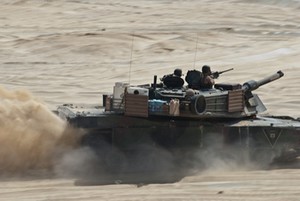Military challengesU.S. military challenged by other nations’ improved abilities to deny access to territory
A U.S. military strategy based primarily on an ability to deploy troops anywhere it feels necessary will face heightened costs and risks in critical regions by 2025, owing to other nations’ improved abilities to deny the U.S. access, according to a new study. Anti-access and area denial are the two biggest threats to the U.S. ability to project its military forces.

U.S. military will find greater difficulty in projecting force // Source: commons.wikimedia.org
A U.S. military strategy based primarily on an ability to deploy troops anywhere it feels necessary will face heightened costs and risks in critical regions by 2025, owing to other nations’ improved abilities to deny the U.S. access, according to a new study by the RAND Corporation.
Anti-access and area denial are the two biggest threats to the U.S. ability to project its military forces. Anti-access is the ability of a nation to keep the armed forces of another from entering its territory. Area denial tends to prevent an entity from operating in an area of tactical distance.
Because of the increased availability and declining costs of militarily important technologies such as computers, networking and global positioning, potential adversaries are developing and fielding long-range sensing, targeting and precision strike capabilities, according to the report.
“Since the end of the Cold War, the United States has been able to use military force wherever and whenever it chose to do so, but as anti-access and area denial systems become more sophisticated, they are going to affect the ability of U.S. military forces to place troops into a specific country or region,” said Terrence K. Kelly, lead author of the study and a senior operations researcher at RAND, a nonprofit research organization.
RAND notes that the study examines the motivations, technology and economics behind the adoption of anti-access and area denial capabilities. It considers why anti-access and area denial is so hard and costly to counter and whether the erosion of U.S. force projection capabilities is unavoidable. It also looks at how such countries as China, Russia and Iran might deploy these capabilities.
The report recommends the U.S. military adopt a strategy based on improving its anti-access and area denial capabilities to increase the costs and risks for would-be regional aggressors, in cooperation with willing allies and partners. This strategy would require allies and partners to be more involved in their own defense against capable nations. Force projection would remain important, but would no longer enjoy the central place it currently holds in U.S. military policy.
In conjunction with a revised approach to using force, the U.S. military also should use “power to coerce” capabilities to deter regional intimidation and low-grade aggression by imposing economic and political costs on those who threaten the U.S. and allied interests.
